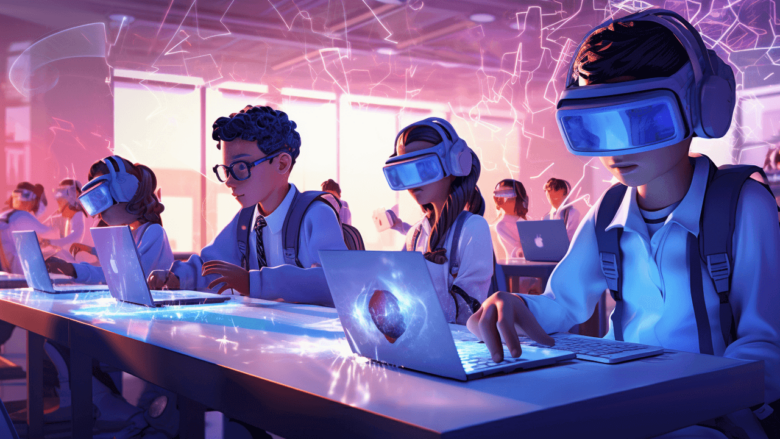The metaverse is today’s reality. It is advancing across different sectors, and education is one of them. With advanced technology, the conventional classroom is shifting into a learning space where students can participate in activities such as digital field trips and experience them virtually. The interaction that the metaverse offers allows learning to be undertaken in a way that is interesting and easy to grasp. The opportunities available are limitless.
It not only encourages enjoyment related to education but also allows for better retention rates. Schools and colleges around the globe are keen to garner its benefits, especially with leading companies putting their resources into Metaverse-powered learning systems. However, what advantages does the metaverse provide, and how is it transforming education? This article intends to explain how the metaverse is used in education, its most important advantages and challenges, and its prospects for digital learning.
Fostering Engagement, Interactivity, and Experiential Learning:
A key problem in education is that students are bored and unmotivated to learn or study. Instructional materials like textbooks and lectures are often monotonous, which leads to boredom and disengagement. The Metaverse enriches the interactivity of education with VR and AR technologies, enabling students to partake in activities that are much more stimulating than rote textbooks.
For example, students can read about ancient civilizations, but they can also go on field trips to visit historical sites, stroll through ancient cities, and interact with actual historical characters. A more hands-on approach helps the students understand concepts and retain information better as compared to passive learning. By broadening the scope of methods available for student engagement, teachers can develop lessons customized to different learners, thus promoting inclusivity and enhancing the learning experience.
Virtual Classrooms and Global Collaboration:
With Metaverse technology, students and teachers can now meet in virtual classrooms without consideration for their geographical locations. Online learning has already become a norm, but the Metaverse takes it a step further by creating a sense of presence that is absent in traditional video calls. In a metaverse classroom, learners can see their classmates and teachers as if they are in a physical classroom, enabling better interaction and collaboration. In addition, learners can take part in international projects, attend virtual workshops, and collaborate with experts globally. Such exposure helps learners to develop a global outlook and appreciation of diverse cultures, which is essential in today’s world.
Hands-On Training With The Use Of The Metaverse:
The metaverse is taking practical learning to a whole new level by providing students with simulations where they can practice skills that correspond with their chosen professions in a safe and controlled environment. Medical students, for example, get to practice ‘hands-on’ experience through virtual surgeries before dealing with actual patients.
Engineering students can build and test structures in a virtual environment before applying their skills in real life. Science students can conduct experiments in a virtual laboratory devoid of the need for expensive laboratory equipment. Such kinds of simulations help in enhancing the mastery of various concepts through the application of practical work. It also enables students to improve their skills through step-by-step learning without real-life consequences.
Enhancing Accessibility and Inclusivity:
The metaverse may help make education more inclusive and accessible. Physical disabilities, financial limitations, and inadequate education opportunities are just a few of the many challenges students face. These obstacles are alleviated through virtual learning environments (VLEs) that are flexible and economical. Students with disabilities can access adaptive learning tools, and learners in remote areas no longer have to relocate to receive a quality education.
Furthermore, the Metaverse’s language translation tools can foster invaluable collaboration among students from diverse linguistic backgrounds. Moreover, the customization of learning environments to suit individual preferences ensures that students will not be left behind in the learning process.
Issues and Challenges of Metaverse Education:
Integrating the metaverse with education poses unique challenges, unlike anything that has come before. One major problem includes the cost of VR and AR technologies. Not all schools and students have the resources to purchase the needed equipment to enter Metaverse learning environments. Additional troubleshooting areas include potential digital addiction issues, reduced physical interactions with peers, and diminished social skills and physical health due to excessive immersion in virtual worlds.
Equally important concerns relate to privacy and security, as virtual classrooms may be subjected to cyberattacks and data theft. Furthermore, teachers need training on the pedagogical application of Metaverse tools. Addressing all these challenges requires careful implementation strategies, comprehensive policies, and targeted investments to ensure safe and efficient Metaverse learning environments.
The Future of Education in the Metaverse:
With technological advancements, the educational opportunities presented in the Metaverse have great potential. Schools and colleges are already venturing into virtual campuses and digital learning spaces. In the coming years, we are likely to see an increase in educational institutions adopting the Metaverse for teaching. Developments in AI will further advance education by providing tailored learning experiences for each student.
The development of blockchain technology will also help secure academic credentials and provide proof of achievement for every student. Although traditional classrooms will not completely disappear, they will likely incorporate more Metaverse features to improve the learning experience. The metaverse has the potential to transform education worldwide by making it more accessible and affordable while also engaging and effectively providing knowledge to learners of the coming generations.
Conclusion:
The Metaverse offers immersive, interactive, and engaging learning experiences, which are reshaping education. It improves learner participation and students’ collaboration on a global scale through simulations and hands-on learning opportunities. Although cost, privacy, digital addiction, and other challenges must be dealt with, the advantages of the Metaverse heavily exceed the disadvantages. In the future, the Metaverse will become part of the education system, in doing so, offering an astonishing new technology to learn and interact with. Virtual classrooms, field trips, and simulations will make engagements, hands-on experience, and learning much more exciting. The metaverse enhances learning with new tools that foster creativity and inclusivity, transforming education as we know it.
FAQs:
1. In what ways does the Metaverse enhance education?
The metaverse enhances education by offering immersive lessons and enabling virtual access to real-world places and situations, which improves learner engagement, helps learners understand complex concepts better, and fosters STEM opportunities.
2. Are traditional classrooms still needed when using the Metaverse?
Although the metaverse enhances education, there is a low likelihood that traditional classrooms will be replaced entirely. Most likely, Metaverse will supplement educational environments by providing additional interaction and ease of access to gain knowledge.
3. What equipment is required to access the Metaverse for educational purposes?
Students might require headsets for virtual reality, devices for augmented reality, or even computers and smartphones to access educational platforms set in the Metaverse. Still, with advances in technology, it is hoped that there will be affordable alternatives.
4. What are the problems associated with the integration of the Metaverse in education?
Some of the challenges include the potential for overspending, the risk of digital addiction, privacy issues, and the necessity for adequate teacher training. Overcoming these obstacles must be done for the effective use of the metaverse for education.
5. Will learning within the Metaverse be economically available for all individuals?
At the moment, education through the Metaverse requires significant investment in VR and AR equipment, making it not very cost-effective. However, it’s hoped that the widespread adoption of new technologies will ultimately drive the price down, improving accessibility for students everywhere.




